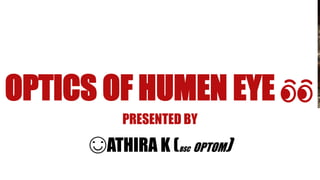
OPTICS OF HUMAN EYE , SCHEMATIC EYE, ANGLE AND AXES OF EYE
- 1. OPTICS OF HUMEN EYE 👀 PRESENTED BY 😊ATHIRA K (BSC OPTOM)
- 2. 1)OPTICAL SYSTEMOF HUMEN EYE:: 2)SCHEMATIC EYE 3)AXES AND ANGLES OF EYE 1)OPTICAL SYSTEM OF HUMEN EYE 2)SCHEMATIC EYE 3)AXES AND ANGLES OF EYE
- 3. HUMEN EYE:: THE HUMAN EYE IS A SENSORY ORGAN, PART OF THE SENSORY NERVOUS SYSTEM, THAT REACTS TO VISIBLE LIGHT AND ALLOWS HUMANS TO USE VISUAL INFORMATION FOR VARIOUS PURPOSES INCLUDING SEEING THINGS, KEEPING BALANCE, AND MAINTAINING CIRCADIAN RHYTHM.
- 5. •HUMANS HAVE TWO EYES, SITUATED ON THE LEFT AND THE RIGHT OF THE FACE. THE EYES SIT IN BONY CAVITIES CALLED THE ORBITS, IN THE SKULL. THERE ARE SIX EXTRAOCULAR MUSCLES THAT CONTROL EYE MOVEMENTS.
- 9. DIMENSIONS OF AN ADULT EYE BALL: ANTEROPOSTERIOR DIAMETER=24MM HORIZONTAL DIAMETER=23.5MM VERTICAL DIAMETER=23MM VOLIUME=6.5ML WEIGHT=7G CICUMFERENCE=75MM
- 13. STRUCTURE OF HUMAN EYE:
- 14. OPTICS OF HUMAN EYE:
- 16. •THE BASIC OPTIC FUNCTION OF THE EYE IS TO FORM AN IMAGE OF WHATEVER OBJECT BEING LOOKED AT (FIXATED ON) ON THE RETINA. THIS IMAGE FORMATION IS DONE BY THE COMBINATION OF THE CORNEA AND THE LENS WHICH BEHAVES LIKE A CONVEX LENS. THE FOCUS
- 17. CORNEA:: NORMALCORNEA::: •PROLATE SHAPE •ANTERIOR SURFACE OF CORNEA :ELIPTICAL •HORIZONTAL DIAMETER=11.7MM •VERTICAL DIAMETER=11MM • POSTERIOR SURFACE OF CORNEA IS CIRCULAR WITH AVERAGE DIAMETER OF 11.5MM • THICKNESS OF CORNEA:::IT VARIES 0.52MM AT CENTRE, 0.8MM AT PERIPHERY IT VARIES FROM 1-1.2MM • AVERAGE CORNEAL THICKNESS=540MICROMETER • ANTERIOR RADIUS OF CURVATURE:7.8MM • POSTERIOR RADIUS OF CURVATURE=6.5MM • REFRACTIVR INDEX=1.376 • REFRACTIVE POWER=+43D
- 18. CRYSTALLINE LENS:: THE LENS IS A TRANSPARENT, BICONVEX,CRYSTALINE STRUCTURE PLACED BETWEEN THE IRIS AND THE VITREOUS IN A SAVIOR SHAPED DEPRESSION CALLED PATTALLAR FOSSA DIAMETER=10MM THICKNESS VARIES WITH AGE:AT BIRTH=3.5MM, AT EXTREME OF AGE=5MM WEIGHT :0-9 YEARS=135MG, 40-80YEARS OF AGE=255MG SURFACES::ANTEEIIR SURFACES IS LESS CONVEX THAN POSTERIOR RADIUS OF CURVATURE ::ANTERIOR -10MM, POSTERIOR =6MM REFRACTIVE INDEX:1.39(MEAN), 1.38(CORTEX),NUCLEAR-1.41 TOTALREFRACTIVE POWER =+15-16D ACCOMODARIVE POWER OF THE LENS VARIES WITH AGE ::AT BIRTH=14-16D,25YEARS OF AGE-7-8D , 50 YEARS OF AGE =1-2D
- 19. VITREOUS HUMOR:: •IT IS A TRANSPARENT, COLORLESS, GEL LIKE SUBSTANCE THAT FILLS THE SPACE BETWEEN THE LENS AND RETINA WITH IN THE EYE. •REFRACTIVE INDEX=1.336 •CONSIST OF 99%WATER , •VOLUME:ABOUT 3 MY PER EYE.
- 20. AQUEOUS HUMOUR:: •IT IS A CLEAR LIQUID INSIDE THE FRONT PART OF THE EYE. •VOLIUME::2MICRO L/M MANTERIORLY-BACK OF THE CORNEA, POSTERIORLY-ANTERIOR SURFACE OF IRIS AND CILIARY BODY. •3MM DEEP
- 23. OPTICAL SYSTEM OF HUMEN EYE::
- 26. SCHEMATIC EYE 👀 :: •A SCHEMATIC EYE IS A MATHEMATICAL OR PHYSICAL MODEL THAT REPRESENTS THE BASIC OPTICAL FEATURES OF THE REAL EYE. •SCHEMATIC EYES HAVE MANY APPLICATIONS, PARTICULAR AS TEACHING AIDS IN OPTICS, OPTOMETRY, OPHTHALMOLOGY, PSYCHOLOGY (VISION AND VISUAL PERCEPTION) AND VISUAL ERGONOMICS. BESIDES SHOWING THE BASIC OPTICAL STRUCTURE OF THE EYE, THE DIMENSIONS AND OTHER OCULAR PARAMETERS ALLOW ONE TO TRACE RAYS THROUGH THE EYE AND DETERMINE THE POSITION, SIZE AND ORIENTATION OF IMAGES AND ASSESS THE ABERRATIONS AND HENCE QUALITY OF THE RETINAL IMAGE.
- 27. HISTORY :: •*THE FIRST PHYSICAL MODEL OF THR EYE-”REAL EYE”-CHRISTIAN HUYGENS(1629-1695) •*SMITH IN 1738,DESCRIBED HUGENS EYE 2 HEMISPHERE, CORNEA&RETINA •*LE GRAND, MOSTER IN 1844 WAS THE FIRST TO CONSTRUCT A THEORETICAL SCHEMATIC EYE •*FIRST ACCURATE SCHEMATIC EYE-LISTING, 1851 •*HELMHOLTZ DEVELOPED A MODIFIED VERSION OF LISTING'S EYE •*TSCHERING PUBLISH A MORE COMPLEX EYE THAT CONTAINED THE POSTERIOR CORNRAL SURFACE, HE CLAIMED TO MEASURE IT FIRST. •*ALLVAR GULLSTRAND DEVELOPED A MORE IMPROVED SCHEMATIC EYE WITH FOUR SURFACE LENS AND EXTRA LENS COMPLEXICITY. •*GULLSTRAND'S NOBEL PRIZE WINNING WORK-SCHEMATIC EYES BEAR HIS NAME
- 31. CARDINAL DATA OF THE GULLSTRAND'S SCHEMATIC EYE:: •*PRINCIPLE FOCI F1 AND F2 LIE 15.7MM IN FRONT AND 24MM BEHIND THE CORNEA •*PRINCIPAL POINTS P1 AND P2 LIE IN THE ANTERIOR CHAMBER 1.35MM AND1.60MM BEHIND THE ANTERIOR SURFACE OF CORNEA •*NODAL POINT N1 AND N2 LIE IN THE POSTERIOR PART OF LENS 7.08MM AND 7.33MM BEHIND THE ANTERIOR SURFACE OF CORNEA
- 33. •THE TOTAL DIOPTRIC POWER OF THIS SCHEMATIC EYE=58.64D •REFRACTIVE INDICES: 1. CORNEA-1.376 2.AQUEOUS-1.336 3.LENS CORTEX-1.386 4.LENS CORE-1.406 5.VITREOUS-1.336
- 34. POSITION OF THE OPTICAL ELEMENTS IN THE EYE IS:: •ANTERIOR SURFACE OF CORNEA-0MM •POSTERIOR SURFACE OF CORNEA-0.5MM •ANTERIOR SURFACE OF LENS-3.6MM •POSTERIOR SURFACE OF LENS CORE-4.146MM •POSTERIOR SURFACE OF LENS CORE-6.505MM
- 35. RADIUS OF CURVATURE OF THE REFRACTIVE SURFACES: •ANTERIOR SURFACE OF CORNEA-7.70MM •POSTERIOR SURFACE OF CORNEA-6.70MM •ANTERIOR SURFACE OF LENS-10.00MM •POSTERIOR SURFACE OF THE LENS-6.00MM •ANTERIOR SURFACE OF THE LENS CORE-7.91MM •POSTERIOR SURFACE OF THE LENS CORE-5.76MM
- 36. ANGLES AND AXES OF EYE::
- 37. •AXES OF THE EYE:: •1)OPTICAL AXIS-THE LINE PASSING THROUGH THR CENTRE OF CORNEA(P)ABD THR CENTRE OF THE LENS(N),AND MEETS THE RETINA(R) ON THE NASAL SIDE OF THE FOVEA. •2)VISUAL AXIS-IT IS THE LINE JOINING THE FIXATION POINT (O), NODAL POINT(N)AND THE FOVEA(F) •3)FIXATION AXIS-IT IS THE LINE JOINING THE FIXATION POINT(O) AND THE CENTRE OF ROTATION(C)
- 39. •VISUAL ANGLES::: •ANGLE ALPHA-IT IS THE ANGLE(ONA)FORMED BETWEEN THE OPTICAL AXIS(AR) AND VISUAL AXIS(OF) AT THE NODAL POINT(N) •2)ANGLE GAMMA-IT IS THE ANGLE(OCA) BETWEEN THE OPTICAL AXIS(AR) AND FIXATION AXIS(OC) AT THE CENTRE OF ROTATION OF THE EYE BALL(C) •3)ANGLE KAPPA-IT IS THE ANGLE (OPA) FORMED BETWEEN THE VISUAL AXIS(OF)AND PUPILLARY LINE (AP)